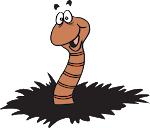As I have written before ( http://www.wormmainea.com/Projects.html and http://wormmainea.blogspot.com/2009/04/retreating-snow-uncovers-presents-from.html), this is a great way to deal with pet waste you pick up in your yard. Far better than putting it in the trash in a sealed plastic bag, because you are composting the waste and using it to fertilize your yard (OK for lawns and perennial plants/trees; NOT OK for garden food areas).
Supplies:
All you need to get started is a roll-top can, 1/2 # of worms, and some leaves, peat, straw, or hay for bedding.
There is not magic to a roll-top trash can, but I think these look OK in the yard and you can open the top with your foot or shovel to make deposits. in my experience, the roll top also keeps critters out of the Doggie Dumpster contents.
I purchased the roll top can for $15 at K-Mart in Waterville. I'm using leaves and I have worms, so those are free.
Construction:
Cut the bottom off of your trash can. I cut the bottom 3/4 inch, leaving me about 16" of can liner. That is a reasonable hole (both from the ability to dig and reasonable volume). My hack saw did the job quickly and neatly. That's really all you need to do.
Selecting a location and installation:
First you want to be sure this is in a place you can be sure that children will not get into it and that this is not in an area that is close to ground water or liable to flooding.
I chose an area in the backyard where the grass could use some help that is out of the way. I used the bottom I had cut off to estimate the diameter of the hole.
After that, it is dig, dig, dig until you can fit the bottom of the can in the hole with the top exposed.
Now you add a thin layer of bedding (leaves, peat, straw or hay) to the bottom and gently put some worms in and cover with another thin layer of bedding. You don't want to add too much bedding, because you want to have space for your additions. I started this one with 1/2 # of worms, you can use more or fewer, but this works for my anticipated input volume. I added about 1 quart of dry bedding (total for top and bottom).
Finally, I back-filled around the hole to fill-in any gaps around the sides of the can. Here is how it looks with the top on.
Use and maintenance:
To make a deposit, add the waste and cover with bedding (leaves, peat, straw or hay). Again, don't add too much bedding, just enough to cover the feces.
Don't bag the poo you put in-- even in a biodegradable bag! The time it takes for the bag to break down would mean that the hole is filling faster than the worms can access the waste.I think this would work best with policing up poo in your yard (where you can use a shovel) or if you already own a pooper scooper
You should not have to add any water to this because it is below ground level.
I would suggest you add more worms if your getting any bad smells, and perhaps add more bedding.
What do I do when the Doggie Dumpster is full?
You will have to repeat the hole digging process when the pit is nearly full. Simply remove the bottomless can liner (wash your hands thoroughly after touching this!). Overall, the process is easy-- your sod circle from your new hold goes on top of the old hole and you water it in. You don't have to buy a new can, and you can use worms out of your worm bin.
Considerations/Limitations:
I would consider these a great addition to a dog park or trail head; however, if users deposit poo in plastic bags it won't work. It could work with some training or information, but I am reluctant to install one at the Eastern Trail Head because of non-compliance and the potential for failure..
Cheers,
Mark













No comments:
Post a Comment